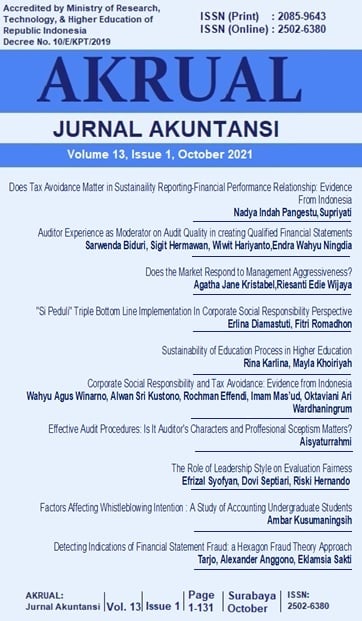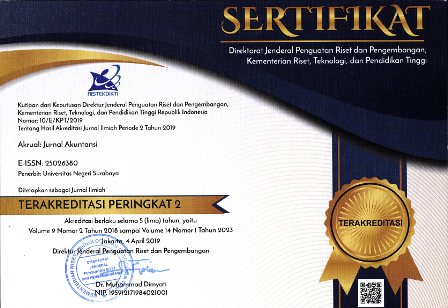Does the Market Respond to Management Aggressiveness?
DOI:
https://doi.org/10.26740/jaj.v13n1.p26-40Keywords:
screening theory, management aggressiveness, market respons, the board of commissioners, foreign institutional ownership, auditorsAbstract
This study aims to examine market behavior towards management aggressiveness from the perspective of screening theory. Screening theory assumes that the market has limited information on companies. This study uses 852 companies taken from companies listed on the IDX from 2016 to 2018. This study provides empirical evidence about the response of capital markets to management aggressiveness. Over-aggressive management is very dangerous for the company. For this reason, the researcher also examines whether the board of commissioners, foreign institutional ownership, and the presence of auditors are capable of improving market response to management aggressiveness. The results provide evidence that the market does not respond to management aggressiveness. It means that the screening theory is able to explain that the market does not consider whether management is aggressive or not in making their investment decisions. However, the existence of foreign institutional ownership as well as the existence of auditors is something that is considered by the market. The market has responded positively to their existence in suppressing management aggressiveness. Thus, Screening theory proves that the market has limited information about company management. However, they require different information from that provided by management in making strategic decisions.
References
Atkinson, J. W. (1957). Motivational determinants of risk-taking behavior. Psychological Review, 64(6p1), 359.
Attah-Boakye, R., Adams, K., Kimani, D., & Ullah, S. (2020). The impact of board gender diversity and national culture on corporate innovation: A multi-country analysis of multinational corporations operating in emerging economies. Technological Forecasting and Social Change, 161, 120247.
Bhatti, K., Husnain, M. I. U., Saeed, A., Naz, I., & Hashmi, S. D. (2021). Are top executives important for earning management and firm risk? Empirical evidence from selected Chinese firms. International Journal of Emerging Markets.
Chatterjee, C. (2019). Board Quality and Earnings Management: Evidence from India. Global Business Review. https://doi.org/10.1177/0972150919856958
Chen, X., Hu, N., Wang, X., & Tang, X. (2014). Tax avoidance and firm value: evidence from China. Nankai Business Review International.
Damak, S. T. (2018). Gender diverse board and earnings management: evidence from French listed companies. Sustainability Accounting, Management and Policy Journal.
Damodaran, A. (2007). Strategic risk taking: a framework for risk management. Pearson Prentice Hall.
Drucker, P. F. (1999). Managing for results: economic tasks and risk-taking decisions. Routledge.
Eagly, Alice H, Wood, W., & Diekman, A. B. (2000). Social role theory of sex differences and similarities: A current appraisal. The Developmental Social Psychology of Gender, 12, 174.
ElKelish, W. W. (2018). Corporate governance risk and the agency problem. Corporate Governance: The International Journal of Business in Society.
Franke, G. R., Crown, D. F., & Spake, D. F. (1997). Gender differences in ethical perceptions of business practices: A social role theory perspective. Journal of Applied Psychology, 82(6), 920. https://doi.org/10.1037/0021-9010.82.6.920
Goldberg, L. (2001). A journey into accounting thought. Routledge.
Goncalves, A. F.,Rossoni, L., & Mendes-Da-Silva, W. (2019). Board social capital reduces implied cost of capital for private companies but not of state-owned companies. Management Decision.
Gottschalk, P. (2018). Fraud investigation: Case studies of crime signal detection. Routledge.
H Greene, W. (2012). Econometric analysis. Pearson Education Limited.
Hayes, R., Wallage, P., & Gortemaker, H. (2014). Principles of auditing: an introduction to international standards on auditing. Pearson Higher Ed.
Hurley, D., & Choudhary, A. (2020). Role of gender and corporate risk taking. Corporate Governance: The International Journal of Business in Society.
Jeppesen, K. K. (2019). The role of auditing in the fight against corruption. British Accounting Review. https://doi.org/10.1016/j.bar.2018.06.001
Kaplan, S. N., &Sorensen, M. (2016). Are CEOs Different? Characteristics of Top Managers. SSRN Electronic Journal. https://doi.org/10.2139/ssrn.2747691
Keynes, J. M. (2018). Ts. (2018). he general theory of employment, interest, and money.Springer.
Kumar, R. (2015). Valuation: theories and concepts.
Li, Z., Wang, P., & Wu, T. (2020). Do foreign institutional investors drive corporate social responsibility? Evidence from listed firms in China. Journal of Business Finance & Accounting.
Srinivasan, R., Wuyts, S., & Mallapragada, G. (2018). Corporate board interlocks and new product introductions. Journal of Marketing. https://doi.org/10.1509/jm.16.0120
Stiglitz, J. E. (1975). The Theory of Screening, Education, and the Distribution of Income. American Economic Review. https://doi.org/10.2307/1804834
Thackeray, W. M. (2018). Women Investors in Fact. Women, Literature and Finance in Victorian Britain: Cultures of Investment, 29.
Trimpop, R. M. (1994). Thepsychology of risk taking behavior. Elsevier.
Wakker, P. P. (2010). Prospect theory: For risk and ambiguity. In Prospect Theory: For Risk and Ambiguity. Cambridge University Press. https://doi.org/10.1017/CBO9780511779329
Yang, L. (2020). Auditor or Adviser? Auditor (In) Dependence and Its Impact on Financial Management. Public Administration Review.
Yates, J. (1992). Risk-taking behavior.John Wiley & Sons.
Yorke, S. M., Amidu, M., & Agyemin-Boateng, C. (2016). The effects of earnings management and corporate tax avoidance on firm value. International Journal of Management Practice. https://doi.org/10.1504/IJMP.2016.076741
Downloads
Published
How to Cite
Issue
Section
License
Copyright (c) 2021 AKRUAL: Jurnal Akuntansi

This work is licensed under a Creative Commons Attribution-NonCommercial 4.0 International License.
 Abstract views: 439
,
Abstract views: 439
, PDF Downloads: 404
PDF Downloads: 404


















